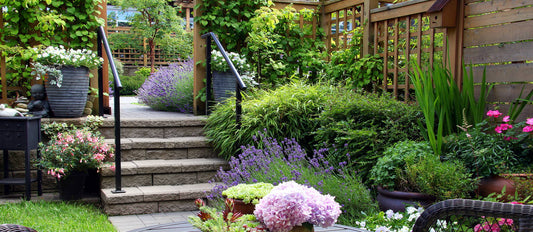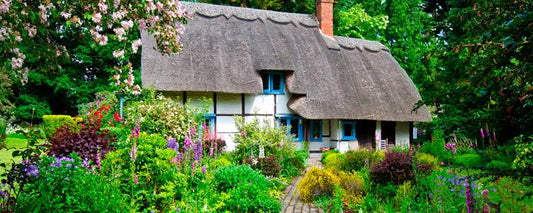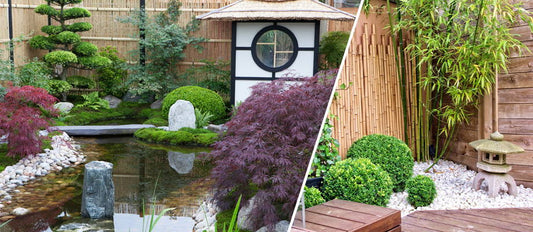A garden full of symbolism, mystery and peace, lots and lots of peace and quiet...
The Japanese garden is somewhat different to the traditional Dutch, English or French garden. A real Japanese garden is full of symbolism and is laid out very precisely with lots of artistry involved. It’s a time consuming job and really, usually only for the real hot-shots with very green fingers. However, if you use just a few characteristic elements, your garden too could be fairly easily transformed into a paradise with Japanese touches.
In order to create the tranquillity of a Japanese garden in your own patch, we have listed a number of easy and handy tips for you below:
The basics: A Japanese garden will always have water, plants and stones. These three basic elements stand for (respectively) life, nature and peace. It’s a good idea to keep this in mind when creating a Japanese garden. The actual garden design to make things Japanese in your garden can then be fairly simple. If you use these three basic elements, you can rather quickly achieve a peaceful and simultaneously intense atmosphere in the garden.
The three basic elements:
1. Water
Water, in the shape of a pretty garden pond is unmissable in the Japanese garden. It needn’t be a large pond but the edges must blend in naturally. Add boulders or gravel to the bottom of the pond and camouflage whatever your pond is made of, with river boulders along the edges too. Try to place your pond so that you create various views of it and not have it totally overseen in one glance – this makes it all so much more natural looking. To add that extra hint of the oriental, you need some fish in your pond. Koi Carp or Goldfish are always popular and very pretty.
2. Stone
Even if you don’t create a pond, you can put boulders to good use in your Japanese garden. For instance, try a meandering gravel path and pale coloured, irregular shaped stepping stones through your bedding. Make sure the layout of the stones is natural looking and keep the total an uneven number for the prettiest, most natural result.
3. Plants
Garden plants in a Japanese garden are characterised by shrubs and trees with fine foliage, in colours of a similar spectrum. A Japanese garden doesn’t have as many flowers as ours traditionally do and there are definitely no bulbs planted in there. Ensure a peaceful colour pallet on any flowering shrubs or flowers and keep the whole tranquil. The perfect plants for a Japanese garden are for instance a graceful, delicately foliaged Japanese Maple (which colours up wonderfully in the autumn!), Ginkgo biloba, Japanese Cherry, Cryptomeria japonica, Pinus (pine), Camelia japonica, Magnolia, Prunus and Hosta.
- Flowers suitable for a Japanese garden are for instance: Astilbe, Begonia grandis, Physalis (ground cherry) and Iris germanica
- Of course no Japanese garden is worth the name without bamboo in it. Check to see when buying your bamboo if it is or is not a variety that tends to take over.
- You will also often see moss in a Japanese garden. Moss doesn’t always thrive in our climes so the low growing ground cover that is creeping juniper (Juniperus horizontalis) is often used instead.
Think of all of the following when you want to add to your Japanese garden:
- The patio or decking – make this slightly raised in (hard) wood and have it run over a strip of fine gravel.
- A Japanese teahouse – paint your current shed or pavilion white and give it a Japanese look with some black lathes of wood attached strategically. A ‘thatched’ roof would immediately add some Japanese atmosphere to your shed too.
- Fencing - Add a touch of the oriental in no time to existing fencing with reed mating, willow wand matting or even bamboo pole mats. Frame your matting with large bamboo stems, spliced lengthwise to finish it all off nicely.
- ‘Japanese’ lanterns and Buddha statues – these are of course real classics in a Japanese garden! Japanese stone lanterns or statues of Buddha really emphasise the look you are going for, but don’t go overboard with statuary. The golden rule is, you should not be able to see more than one garden statue at a time.
Tip!
The popular Japanese bonsai is a manner of pruning – we’ve all see those small trees and shrubs in pretty planters. Bonsai trees are usually used as houseplants. You could also create a ‘giant’ bonsai for in your Japanese garden. You need (preferably) an evergreen bush like Taxus (yew), Buxus (box) Juniperus (juniper), Ilex crenata (holly) or Ligustrum (privet). Begin small and leave only well placed side shoots on the plant. Each side shoot should be allowed to have sprouting leaves on the end. Prune your bonsai into shape in May and September, although of course you can prune it more often if you like.




